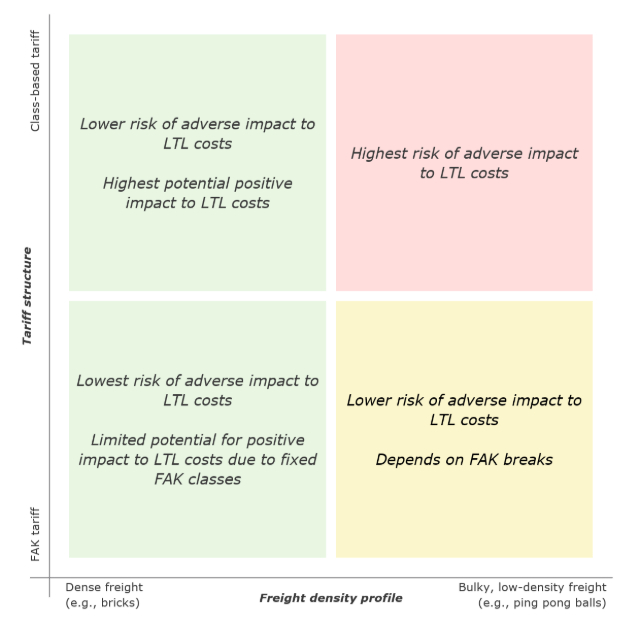- within Transport topic(s)
- in United States
- with readers working within the Advertising & Public Relations and Property industries
- with readers working within the Advertising & Public Relations and Property industries
The less-than-truckload (LTL) freight classification system, which has a key influence on LTL costs in the US, will change on July 19, 2025. This change will likely result in cost changes (both increases and decreases) for shippers depending on their existing agreements, freight profile, and accuracy of reported shipment weight and dimensional information.
In this executive overview, you'll find:
- What is changing?
- Potential impact for LTL shippers
- Practical steps for LTL shippers to prepare and manage the change
- How carriers and logistics service providers can best support their customers
What is changing?
On July 19, 2025, the National Motor Freight Classification (NMFC) system will undergo one of its most significant transformations, shifting from a complex and outdated commodity-based classification system to a density-driven model.
Current classification system (prior to July 19, 2025)
The current LTL classification system assigns a freight class to a commodity based on four characteristics:
- Density – estimated pounds per cubic foot of the commodity
- Stowability - how easily freight can be loaded, stored, and transported with other freight
- Handling - how easily the freight can be moved using standard equipment (e.g., Forklifts)
- Liability - the risk of damage, theft, or loss
The current classification system assigns a freight class based on these four characteristics to over 5,000 different commodities. This system and the assigned classes by commodity have been in place since the early 1980's. Since the 1980's many commodities' characteristics, especially density, have changed significantly due to advancements in lightweight materials (making items less dense) and packaging (often improving item's 'handleability').
New classification system (as of July 19, 2025)
Under the new classification system, a shipment's freight class will be determined by its density (e.g., pounds per cubic foot)— calculated from its weight and dimensions — as opposed to its commodity and that commodity's assigned freight class. To account for stowability, handling, and liability, a new special handling identifier or flag (and potential assessorial charges) will be used.
As part of this change, the National Motor Freight Traffic Association (NMFTA) will consolidate and modernize roughly 2,000 commodity listings, combining similar items to reduce complexity and make it easier to select appropriate classifications.
Potential impact for LTL shippers
Most LTL shippers will see their freight classes change under the new system. Their top concern is what impact the new system will have on total transportation spending.
The answer: it depends on several variables. Among all variables, two key variables that will influence the effect of this change on an LTL shipper are:
- Freight density profile – dense vs bulky freight
- Current tariff structure – FAK (Freight of All Kinds) vs. class-based pricing
Freight density profile:
Lower-density shipments — generally those under 4 pounds per cubic foot — may see increased costs, as LTL carriers are compensated primarily by weight, but must also account for the trailer space used by light, bulky freight. These shipments are expected to see upward price adjustments under the new scale. The degree to which lower-density shipments are affected by the system change depends on the commodity and its classification under the current system.
Current tariff structure:
Shippers with an FAK (Freight of All Kinds) tariff, a tariff that allows multiple NMFC classes (e.g., 70–125) across multiple commodities to be billed as a single agreed class (e.g., Class 85), will likely see a limited effect of the classification system change. This is due to freight classes and commodities already being grouped into large bands, greatly muting the impact of freight class variability. However, if a shipper's freight new class falls into a different FAK tariff band, the effect of the change could be exacerbated.
Matrix to help shippers quickly assess the potential cost impact of the NMFC LTL classification system on their supply chain

An illustrative matrix on how to assess the potential impact of the NMFC classification system change for an LTL shipper
Other variables that may impact how the classification system change will affect a shipper's LTL costs are stowability, handling, and liability characteristics that may trigger new flags/ exceptions, accuracy of dimensional data, and current carrier relationships.
While the new LTL classification system is intended to improve transparency, it may also give carriers leverage to implement price increases, particularly for low-density or irregular freight. The shift to density-based ratings and the use of special handling flags make it easier for carriers to reclassify shipments and assign higher freight classes. Shippers should be aware of these dynamics as they evaluate the impact on their transportation costs.
Practical steps for LTL shippers to prepare for and manage the change
Proactive preparation will help shippers mitigate cost surprises and ensure a smooth transition. Key steps include:
- Review impact: Leverage LTL carriers (current or prospective) and/or your logistics service providers to assess the potential impact on LTL shipping costs.
- Update systems: Ensure your Transportation Management System (TMS), Warehouse Management System (WMS), and Enterprise Resource Planning (ERP) systems have accurate weight and dimension information and/or reflect the new classification structure to avoid billing discrepancies and resource-intensive rebills.
- Educate your teams: Work closely with your logistics partners to train internal teams on the new rules and required data accuracy.
- Optimize packaging: Review current packaging practices to maximize shipment density, stowability, and handling where possible to improve your freight class and lower/ maintain your LTL costs.
How LTL carriers and logistics service providers can best support their customers
LTL carriers and logistics service providers should also prepare by training staff on the new classification logic and proactively communicating these changes to customers. Customer-centric LTL carriers and logistics service providers will assess customers' potential impact and rework tariff structures to ensure economic success for both parties.
Final Thoughts
This is one of the most significant changes the LTL market has seen in decades. The good news? Shippers who prepare thoughtfully now can turn this transition into an advantage. This change also provides carriers with a chance to set themselves apart from the pack by proactively working with customers to manage the transition thoughtfully.
The content of this article is intended to provide a general guide to the subject matter. Specialist advice should be sought about your specific circumstances.




